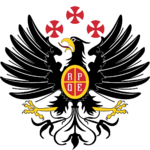United Kingdom of Etruria
United Kingdom of Etruria Regno Unito d'Etruria | |||||||||||||||
|---|---|---|---|---|---|---|---|---|---|---|---|---|---|---|---|
| 1736-1793 | |||||||||||||||
| Motto: Benedicici di Madre Maria "Bless us Mother Mary" | |||||||||||||||
| Anthem: Canto Reale della Terra "Royal Song of the Land" | |||||||||||||||
| Capital | Poveglia | ||||||||||||||
| Government | Constitutional monarchy | ||||||||||||||
| King | |||||||||||||||
• 1736-1773 | Adriano Augusto I | ||||||||||||||
• 1773-1790 | Adriano Augusto II | ||||||||||||||
• 1790-1793 | Adriano Augusto III | ||||||||||||||
| Prime Minister | |||||||||||||||
• 1736-1744 | Umberto Ricasoli (first) | ||||||||||||||
• 1765-1788 | Agostino Urbano Farini, Conte di Servina | ||||||||||||||
• 1792-1793 | Bendetto Starabba (last) | ||||||||||||||
| Legislature | Senate of Etruria | ||||||||||||||
| Chamber of the Esteemed | |||||||||||||||
| Chamber of the Noble | |||||||||||||||
| History | |||||||||||||||
| 10 November 1736 | |||||||||||||||
| 1764-1771 | |||||||||||||||
| 11 October 1788 | |||||||||||||||
| 1793 | |||||||||||||||
| 18 September 1793 | |||||||||||||||
| Currency | Piastra | ||||||||||||||
| |||||||||||||||
The United Kingdom of Etruria (Vespasian: Regno Unito d'Etruria) was the first united Etrurian state since the Solarian Empire that existed between 1736 and 1793. It was an Euclean great power and early coloniser with possessions around the globe.
The unified Etrurian monarchy arose out of the aftermath of the Pereramonic Wars, with the Vicalvi-based House of Caltarini assuming power over the Kingdom of Bettona in 1727. From 1728 until 1736, the Bettona under Adriano Agusuto I successfully led a series of diplomatic and military campaigns, known as the Risurrezione aimed at unifying Etruria into one singular state. Following unification, Adriano Agusuto sought to consolidate his new kingdom with the introduction of an elected legislature subordinate to the crown. The same time, he sought to rebuild Etrurian military power, creating a royal navy and army. The new kingdom would engage in a series of limited colonial conflicts in Coius and Hydana, as well as campaigns outside of Euclea, the most prominent and costly was the country's involvement in the Asterian War of Secession.
Adriano Augusto I's constitutionalism was undermined by his son and successor, Adriano Augusto II who questioned his father's trust in politicians. A steady decline in the legislature's power coincided with the king's often costly and risky military ventures. Unable to confront the financial burden of Etruria's support for Asterian independence, the crown would become effectively bankrupt in 1776. Increased taxation, corruption depressed the Etrurian economy throughout the 1780s. In 1788, the country was struck by a major San Giorgio Earthquake, which killed over 200,000 people and devastated large portions of southern Vespasia and northern Novalia. The government's poor response and widespread belief that the earthquake was a sign of divine anger led to a collapse in support for the Caltarini dynasty. Bread riots between 1791 and 1793 culminated in the Etrurian Revolution of 1793, which overthrew the monarchy and the saw the execution of King Adriano Augusto III, his wife Isabella Maria and the establishment of a radical republic.
The monarchy would be restored in 1810, establishing the Kingdom of Etruria. The legacy of the first unified state was to establish the first collective "Etrurian" identity among the three primary constituent peoples of the country, while the imposition of a constitutional monarchy also planted long-term ideals of separation of powers, elections and an opposition to absolutism.


